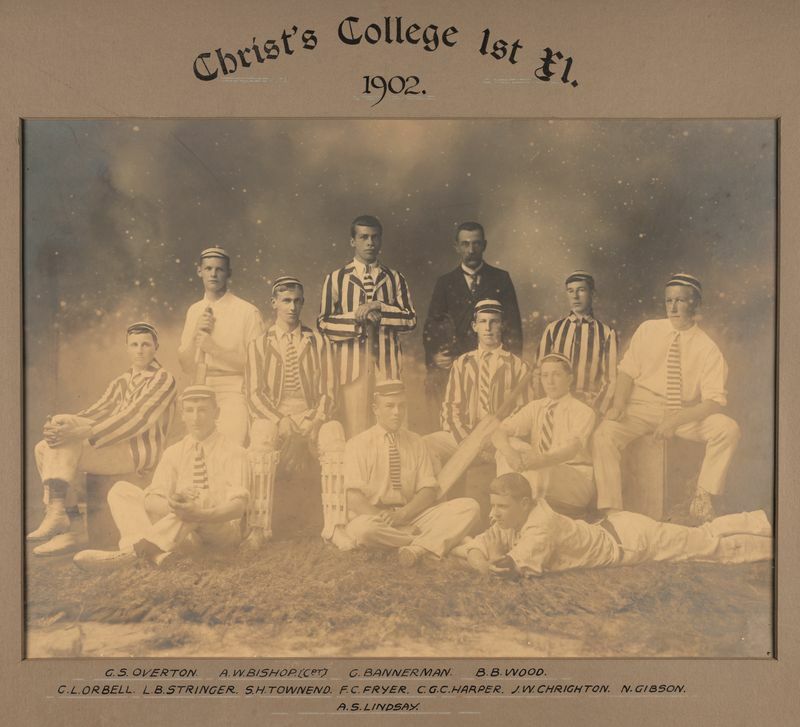Cricket and Rugby teams, 120 years ago
23 Mar 2022
In 1902, the 1st XV and 1st XI went to a studio[i]
to have their photographs taken.[ii]
For the 1st XV, this meant taking a football, carrying their flag, and attaching it to a studio prop that resembled goal posts and putting on their jerseys, shorts, long socks, boots, and caps.

For the 1st XI, it meant taking bats, balls, and wicketkeeper’s pads and gloves to the studio. Team members who had been awarded colours needed to make sure they had their cricket blazer. Everyone took their boots and ties with various stripes. With no studio backdrop, they perched on seats or lay on the same rustic floor covering that appears beneath the boots of the 1st XV.

What happened to these 19 boys in the years that followed?
Many of them were in New Zealand or overseas regiments during World War I.
Alfred Stewart Lindsay (1818), Louis Bruce Stringer (1901), Roger Ingram Dansey (1975), and Drummond Holderness (1648) survived to become, respectively, an insurance inspector, doctor, engineer, and superintendent of the Auckland Harbour Board.
Guy Stanley Overton (1662), George Augustus King (1884), Alfred Wedderburn Bishop (1872), Frederick Andrew Anderson (1695), John Alexander Huntley Holmes (1965), James Home Aitken (1728), and James Wilfrid Crichton (1916) were either killed in action or died of wounds.
Charles Godfrey Cracroft Harper (1751), Bernard Bedingfield Wood (1719), Charles Leslie Orbell (1794), and Sydney Harvey Townend (1772) became farmers. Thomas Overbury Fox (1936) and Charles Waring Somes Saxton (2064) became engineers, Frank Cunningham Fryer (1744) a dentist, and Noel Mackenzie Phillips Gibson (1706) a headmaster.
What of the coaches? John Ulrich (Jock) Collins, who coached the 1st XV, does not appear in this photograph, nor is he named in the accounts of the 1902 games that appear in the September Register of that year.[iii] He did coach them to a 20–6 win against Christchurch Boys’ High School and 13–12 in College’s favour against Otago Boys’ High School, but lost 0–25 against a heavier Wanganui Collegiate School.

On the other hand, Charles Bannerman, the coach of the 1st XI, receives two full pages in the same Register.[iv] Employed as College’s first exclusive cricket coach, he was a former member of the Australian Cricket XI. He was responsible for not only for the improvement in the 1st XI, but also in the 2nd XI and the various junior teams. Local clubs provided the most opposition. However, a win by an innings and 158 runs against Christchurch Boys’ High School was a notable achievement, largely brought about by Harper’s 102 runs and Stringer’s 9 for 39, Harper’s 6 for 27 and Lindsay’s 2 for 32.[v]
[i] The name of the studio is not known. There were several photographic studios in Christchurch at this time.
[ii] Both photographs have been digitised to ensure their longevity. The photograph of the 1st XI has already deteriorated, probably a combination of poor initial fixing and then long exposure to heat and light. The initials and spelling of surnames that appear on the photographs are not necessarily those which appear in full in the School List 1850–1950. The information in the List has been used to clarify information.
[iii] Christ’s College Register, September 1902 pages 174–184. Collins is named as the coach in the 1850–1950 School List.
[iv] Christ’s College Register, September 1902 pp 167–169. See also Forbes, M.Z. 2006 (online) Bannerman, Charles (1851-1930) Australian Dictionary of Biography https://adb.anu.edu.au/biography/bannerman-charles-2929
[v] Christ’s College Register, December 1902 pages 219–229. See also Press 27 November 1902.
